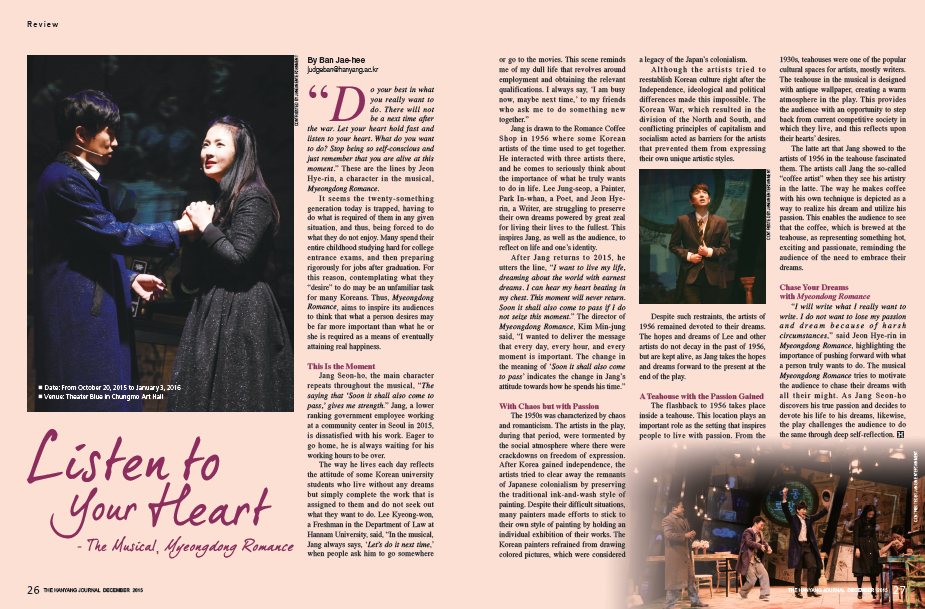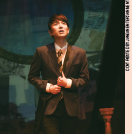

“Do your best in what you really want to do. There will not be a next time after the war. Let your heart hold fast and listen to your heart. What do you want to do? Stop being so self-conscious and just remember that you are alive at this moment.” These are the lines by Jeon Hye-rin, a character in the musical, Myeongdong Romance.
It seems the twenty-something generation today is trapped, having to do what is required of them in any given situation, and thus, being forced to do what they do not enjoy. Many spend their entire childhood studying hard for college entrance exams, and then preparing rigorously for jobs after graduation. For this reason, contemplating what they “desire” to do may be an unfamiliar task for many Koreans. Thus, Myeongdong Romance, aims to inspire its audiences to think that what a person desires may be far more important than what he or she is required as a means of eventually attaining real happiness.
This Is the Moment
Jang Seon-ho, the main character repeats throughout the musical, “The saying that ‘Soon it shall also come to pass,’ gives me strength.” Jang, a lower ranking government employee working at a community center in Seoul in 2015, is dissatisfied with his work. Eager to go home, he is always waiting for his working hours to be over.
The way he lives each day reflects the attitude of some Korean university students who live without any dreams but simply complete the work that is assigned to them and do not seek out what they want to do. Lee Kyeong-won, a Freshman in the Department of Law at Hannam University, said, “In the musical, Jang always says, ‘Let’s do it next time,’ when people ask him to go somewhere or go to the movies. This scene reminds me of my dull life that revolves around employment and obtaining the relevant qualifications. I always say, ‘I am busy now, maybe next time,’ to my friends who ask me to do something new together.”
Jang is drawn to the Romance Coffee Shop in 1956 where some Korean artists of the time used to get together. He interacted with three artists there, and he comes to seriously think about the importance of what he truly wants to do in life. Lee Jung-seop, a Painter, Park In-whan, a Poet, and Jeon Hyerin, a Writer, are struggling to preserve their own dreams powered by great zeal for living their lives to the fullest. This inspires Jang, as well as the audience, to reflect on life and one’s identity.
After Jang returns to 2015, he utters the line, “I want to live my life, dreaming about the world with earnest dreams. I can hear my heart beating in my chest. This moment will never return. Soon it shall also come to pass if I do not seize this moment.” The director of Myeongdong Romance, Kim Min-jung said, “I wanted to deliver the message that every day, every hour, and every moment is important. The change in the meaning of ‘Soon it shall also come to pass’ indicates the change in Jang’s attitude towards how he spends his time.”
With Chaos but with Passion
The 1950s was characterized by chaos and romanticism. The artists in the play, during that period, were tormented by the social atmosphere where there were crackdowns on freedom of expression. After Korea gained independence, the artists tried to clear away the remnants of Japanese colonialism by preserving the traditional ink-and-wash style of painting. Despite their difficult situations, many painters made efforts to stick to their own style of painting by holding an individual exhibition of their works. The Korean painters refrained from drawing colored pictures, which were considered a legacy of the Japan’s colonialism.
Although the artists tried to reestablish Korean culture right after the Independence, ideological and political differences made this impossible. The Korean War, which resulted in the division of the North and South, and conflicting principles of capitalism and socialism acted as barriers for the artists that prevented them from expressing their own unique artistic styles.
Despite such restraints, the artists of 1956 remained devoted to their dreams. The hopes and dreams of Lee and other artists do not decay in the past of 1956, but are kept alive, as Jang takes the hopes and dreams forward to the present at the end of the play.
A Teahouse with the Passion Gained
The flashback to 1956 takes place inside a teahouse. This location plays an important role as the setting that inspires people to live with passion. From the 1930s, teahouses were one of the popular cultural spaces for artists, mostly writers. The teahouse in the musical is designed with antique wallpaper, creating a warm atmosphere in the play. This provides the audience with an opportunity to step back from current competitive society in which they live, and this reflects upon their hearts’ desires.
The latte art that Jang showed to the artists of 1956 in the teahouse fascinated them. The artists call Jang the so-called “coffee artist” when they see his artistry in the latte. The way he makes coffee with his own technique is depicted as a way to realize his dream and utilize his passion. This enables the audience to see that the coffee, which is brewed at the teahouse, as representing something hot, exciting and passionate, reminding the audience of the need to embrace their dreams.
Chase Your Dreams with Myeondong Romance
“I will write what I really want to write. I do not want to lose my passion and dream because of harsh circumstances,” said Jeon Hye-rin in Myeongdong Romance, highlighting the importance of pushing forward with what a person truly wants to do. The musical Myeongdong Romance tries to motivate the audience to chase their dreams with all their might. As Jang Seon-ho discovers his true passion and decides to devote his life to his dreams, likewise, the play challenges the audience to do the same through deep self-reflection.
THE HA


